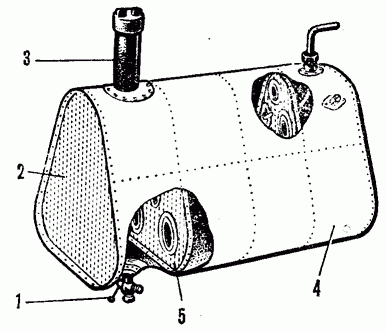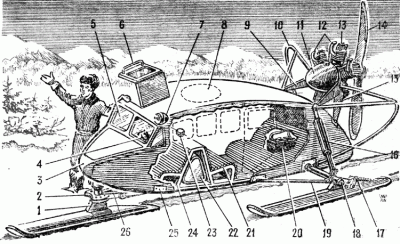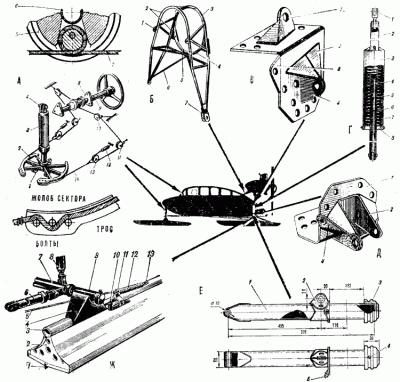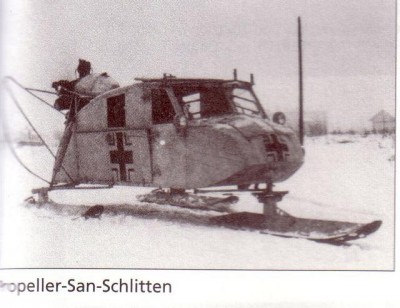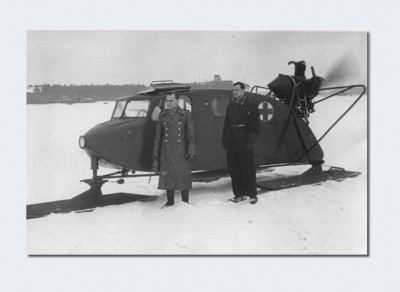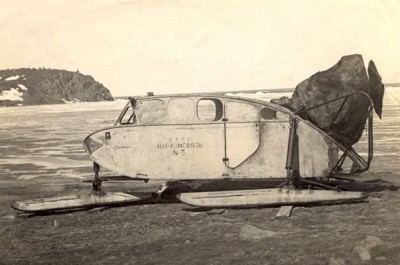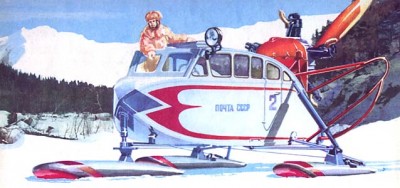OSGA-6 (NKL-6)
& amp; nbsp; & amp; nbsp; & amp; nbsp; & amp; nbsp; & amp; nbsp; Six-seater OSGA-6 sleds ( (i]) later NKL-6 ( & # 1053; & # 1050; & # 1051; -6) were the third type of OSGA. The fuselage of a wooden type with a plywood cover was built on three skis, the front of which was movable. It was aerodynamically shaped, a covered engine unit with a propeller was hung at the stern. The most stressed nodes - engine suspension, chassis leg anchorage and machine gun - were additionally reinforced. The night operation was also enabled by a powerful headlight, located on the bow and powered by an 80 Ah battery.
& amp; nbsp; & amp; nbsp; & amp; nbsp; & amp; nbsp; & amp; nbsp; Unlocking was possible from inside the cabin, similar to aircraft. There was a step under the manhole and handles on the cover. On the left side was the door to the passenger compartment. Although the driver and mechanic had their own hatch, the interior of the cab was not divided.
& amp; nbsp; & amp; nbsp; & & quot; In the passenger version, benches for 4 passengers were used, sitting facing each other. This arrangement was due to the location of the fuel tank, which was in the middle of the cabin, hidden between the first and second rows of seats. The top of the tank was hidden by a common backrest, from the top of which a filling neck protruded. The inside of the cabin was covered with leatherette, as was the bench. In the passenger version, the cabin windows could be covered with silk curtains. In the ambulance variant, the space was adapted to accommodate stretchers. The interior lighting provided ceiling light. The military version had the cabin ceiling modified to install a machine gun on the orbit. To shoot, the shooter had to stand up and protrude above the outline of the vehicle. The machine gun shield was a partial protection for him.
& amp; nbsp; & amp; nbsp; & amp; nbsp; & amp; nbsp; & amp; nbsp; Here, too, the lessons of the aviation industry are known. The control of the front ski was performed by means of a rope wound on a drum placed on the steering column. The drum had a cable groove and a tensioner pulley, preventing the cable from slipping. From the drum, the cable led through a pulley system to a double circular section, attached to the leg of the front ski. The front leg could be moved slightly in its attachment to the chassis leg.
The skis were used in two types - wooden cigar-shaped, made by coating the skeleton with plywood, or from metal plates welded to the angular skeleton. They also had a concave concave upper side. Whether all-metal skis or wooden with a duralumin base were used, they had grooves milled at their bottom to make driving easier and maintain a stable direction. The front skis had a flexible rear attachment, so they should point slightly below the longitudinal axis of the vehicle when unloaded. The attachment of the skis to the chassis was reinforced with struts.
The rear skis were attached to the right and left half-axles, anchored to the fuselage. Forward on the joint on the lower edge of the torso, backwards by the spring from the half-axle to the rear of the ski. A spring shock absorber was anchored to the upper edge of the fuselage. Both the engine frame and the propeller protection frame were also mounted here.
& amp; nbsp; & amp; nbsp; & amp; nbsp; & amp; nbsp; & amp; nbsp; By depressing the pedal, the driver could brake either both skis at once or just one.
The power unit was located on a frame outside the cab. The whole set could be removed from the vehicle as one unit. The engine frame was made of two curved tubes, firmly connected at the bottom. An engine with an oil tank and a propeller was bolted to them. An oil tank was mounted on the cross tube of the frame.A filler neck and one thermally insulated inlet and outlet outlets connected to the engine oil system led to it. Heating pipes, which supplied warm air from the engine, were also routed around them. The unit was covered with an aerodynamic cover, which was both to improve driving characteristics and to reduce excessive cooling of the engine and oil system. The engine exhaust system was also an integral part. The upper 3 cylinders had individual exhausts, cut obliquely so that the vacuum created while driving helped to empty them. The exhausts of the lower 2 cylinders led through an aerodynamic cover, while their heat heated both the oil distribution and the carburetor of the engine.
The M - 11 aircraft engine was used, and later other versions - such as the M - 11V and S - 11D. Electric ignition, provided by a pair of magnets type BSM - 5. To ensure reliability, each had its own circuit circuit, so that each cylinder was operated simultaneously by both. In case of complications during starts in extreme cold, the driver also had a manual starting magneto available in the cab.
& amp; nbsp; & amp; nbsp; & amp; nbsp; & amp; nbsp; & amp; nbsp; 2.35 and 2.4 m, mounted directly on the engine crankshaft. The leading edges and ends of the propeller blades were chained for their greater resistance to accidental collisions with vegetation or snow. The propeller was covered by a simple tubular frame, attached to the anchor points of the engine. For safety reasons, the frame was painted bright red and, like aircraft, bore colored position lights - red and green.
Attention is paid to the OSGA-6 not only because it lasted in production and service, even after OSGA was discontinued and continued to operate. called NKL-6, but also because it became the starting point for another series of NKL aerosols - types NKL - 16/41, NKL - 16/42 and NKL - 26.
Sources:
http://mkmagazin.almanacwhf.ru/venicle/osga_6.htm
http://mkmagazin.almanacwhf.ru/armor/km_4.htm
and archive of authors
Pramen v textu
pramen v textu
Pramen v textu
Pramen v textu
pramen v textu
Pramen v textu
Pramen v textu
Pramen v textu
& amp; nbsp; & amp; nbsp; & amp; nbsp; & amp; nbsp; & amp; nbsp; Six-seater OSGA-6 sleds ( (i]) later NKL-6 ( & # 1053; & # 1050; & # 1051; -6) were the third type of OSGA. The fuselage of a wooden type with a plywood cover was built on three skis, the front of which was movable. It was aerodynamically shaped, a covered engine unit with a propeller was hung at the stern. The most stressed nodes - engine suspension, chassis leg anchorage and machine gun - were additionally reinforced. The night operation was also enabled by a powerful headlight, located on the bow and powered by an 80 Ah battery.
& amp; nbsp; & amp; nbsp; & amp; nbsp; & amp; nbsp; & amp; nbsp; Unlocking was possible from inside the cabin, similar to aircraft. There was a step under the manhole and handles on the cover. On the left side was the door to the passenger compartment. Although the driver and mechanic had their own hatch, the interior of the cab was not divided.
& amp; nbsp; & amp; nbsp; & & quot; In the passenger version, benches for 4 passengers were used, sitting facing each other. This arrangement was due to the location of the fuel tank, which was in the middle of the cabin, hidden between the first and second rows of seats. The top of the tank was hidden by a common backrest, from the top of which a filling neck protruded. The inside of the cabin was covered with leatherette, as was the bench. In the passenger version, the cabin windows could be covered with silk curtains. In the ambulance variant, the space was adapted to accommodate stretchers. The interior lighting provided ceiling light. The military version had the cabin ceiling modified to install a machine gun on the orbit. To shoot, the shooter had to stand up and protrude above the outline of the vehicle. The machine gun shield was a partial protection for him.
& amp; nbsp; & amp; nbsp; & amp; nbsp; & amp; nbsp; & amp; nbsp; Here, too, the lessons of the aviation industry are known. The control of the front ski was performed by means of a rope wound on a drum placed on the steering column. The drum had a cable groove and a tensioner pulley, preventing the cable from slipping. From the drum, the cable led through a pulley system to a double circular section, attached to the leg of the front ski. The front leg could be moved slightly in its attachment to the chassis leg.
The skis were used in two types - wooden cigar-shaped, made by coating the skeleton with plywood, or from metal plates welded to the angular skeleton. They also had a concave concave upper side. Whether all-metal skis or wooden with a duralumin base were used, they had grooves milled at their bottom to make driving easier and maintain a stable direction. The front skis had a flexible rear attachment, so they should point slightly below the longitudinal axis of the vehicle when unloaded. The attachment of the skis to the chassis was reinforced with struts.
The rear skis were attached to the right and left half-axles, anchored to the fuselage. Forward on the joint on the lower edge of the torso, backwards by the spring from the half-axle to the rear of the ski. A spring shock absorber was anchored to the upper edge of the fuselage. Both the engine frame and the propeller protection frame were also mounted here.
& amp; nbsp; & amp; nbsp; & amp; nbsp; & amp; nbsp; & amp; nbsp; By depressing the pedal, the driver could brake either both skis at once or just one.
The power unit was located on a frame outside the cab. The whole set could be removed from the vehicle as one unit. The engine frame was made of two curved tubes, firmly connected at the bottom. An engine with an oil tank and a propeller was bolted to them. An oil tank was mounted on the cross tube of the frame.A filler neck and one thermally insulated inlet and outlet outlets connected to the engine oil system led to it. Heating pipes, which supplied warm air from the engine, were also routed around them. The unit was covered with an aerodynamic cover, which was both to improve driving characteristics and to reduce excessive cooling of the engine and oil system. The engine exhaust system was also an integral part. The upper 3 cylinders had individual exhausts, cut obliquely so that the vacuum created while driving helped to empty them. The exhausts of the lower 2 cylinders led through an aerodynamic cover, while their heat heated both the oil distribution and the carburetor of the engine.
The M - 11 aircraft engine was used, and later other versions - such as the M - 11V and S - 11D. Electric ignition, provided by a pair of magnets type BSM - 5. To ensure reliability, each had its own circuit circuit, so that each cylinder was operated simultaneously by both. In case of complications during starts in extreme cold, the driver also had a manual starting magneto available in the cab.
& amp; nbsp; & amp; nbsp; & amp; nbsp; & amp; nbsp; & amp; nbsp; 2.35 and 2.4 m, mounted directly on the engine crankshaft. The leading edges and ends of the propeller blades were chained for their greater resistance to accidental collisions with vegetation or snow. The propeller was covered by a simple tubular frame, attached to the anchor points of the engine. For safety reasons, the frame was painted bright red and, like aircraft, bore colored position lights - red and green.
Attention is paid to the OSGA-6 not only because it lasted in production and service, even after OSGA was discontinued and continued to operate. called NKL-6, but also because it became the starting point for another series of NKL aerosols - types NKL - 16/41, NKL - 16/42 and NKL - 26.
Sources:
http://mkmagazin.almanacwhf.ru/venicle/osga_6.htm
http://mkmagazin.almanacwhf.ru/armor/km_4.htm
and archive of authors
| Period | - |
| Type | - |
| Camouflage | - |
| Country | - |
| Production No. | - |
| Poznávací značka / evidenční číslo | - |
| Tactical marking | - |
| Name | - |
| Unit | - |
| Date (DD.MM.RRRR) | - |
| Author | - |
| Print size / 300 DPI | - |
| Published with authors permit | - |
| Author Website | - |
Pramen v textu
| Period | - |
| Type | - |
| Camouflage | - |
| Country | - |
| Production No. | - |
| Poznávací značka / evidenční číslo | - |
| Tactical marking | - |
| Name | - |
| Unit | - |
| Date (DD.MM.RRRR) | - |
| Author | - |
| Print size / 300 DPI | - |
| Published with authors permit | - |
| Author Website | - |
pramen v textu
| Period | - |
| Type | - |
| Camouflage | - |
| Country | - |
| Production No. | - |
| Poznávací značka / evidenční číslo | - |
| Tactical marking | - |
| Name | - |
| Unit | - |
| Date (DD.MM.RRRR) | - |
| Author | - |
| Print size / 300 DPI | - |
| Published with authors permit | - |
| Author Website | - |
Pramen v textu
| Period | - |
| Type | - |
| Camouflage | - |
| Country | - |
| Production No. | - |
| Poznávací značka / evidenční číslo | - |
| Tactical marking | - |
| Name | - |
| Unit | - |
| Date (DD.MM.RRRR) | - |
| Author | - |
| Print size / 300 DPI | - |
| Published with authors permit | - |
| Author Website | - |
Pramen v textu
| Period | - |
| Type | - |
| Camouflage | - |
| Country | - |
| Production No. | - |
| Poznávací značka / evidenční číslo | - |
| Tactical marking | - |
| Name | - |
| Unit | - |
| Date (DD.MM.RRRR) | - |
| Author | - |
| Print size / 300 DPI | - |
| Published with authors permit | - |
| Author Website | - |
pramen v textu
| Period | - |
| Type | - |
| Camouflage | - |
| Country | - |
| Production No. | - |
| Poznávací značka / evidenční číslo | - |
| Tactical marking | - |
| Name | - |
| Unit | - |
| Date (DD.MM.RRRR) | - |
| Author | - |
| Print size / 300 DPI | - |
| Published with authors permit | - |
| Author Website | - |
Pramen v textu
| Period | - |
| Type | - |
| Camouflage | - |
| Country | - |
| Production No. | - |
| Poznávací značka / evidenční číslo | - |
| Tactical marking | - |
| Name | - |
| Unit | - |
| Date (DD.MM.RRRR) | - |
| Author | - |
| Print size / 300 DPI | - |
| Published with authors permit | - |
| Author Website | - |
Pramen v textu
| Period | - |
| Type | - |
| Camouflage | - |
| Country | - |
| Production No. | - |
| Poznávací značka / evidenční číslo | - |
| Tactical marking | - |
| Name | - |
| Unit | - |
| Date (DD.MM.RRRR) | - |
| Author | - |
| Print size / 300 DPI | - |
| Published with authors permit | - |
| Author Website | - |
Pramen v textu
